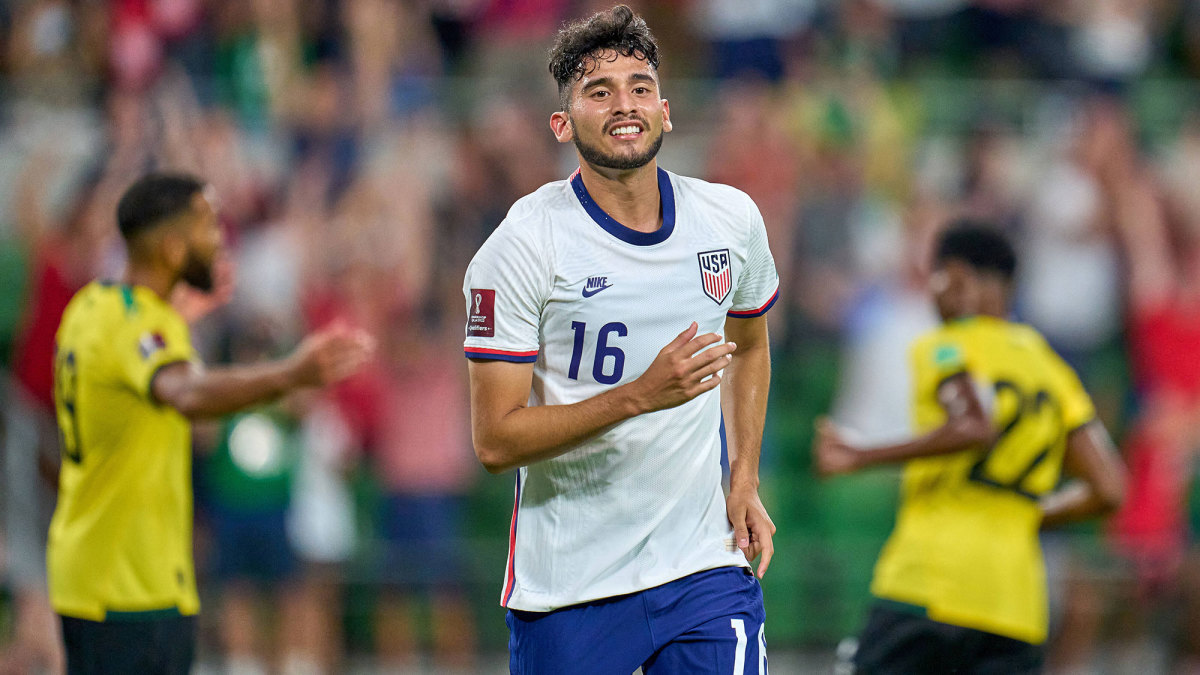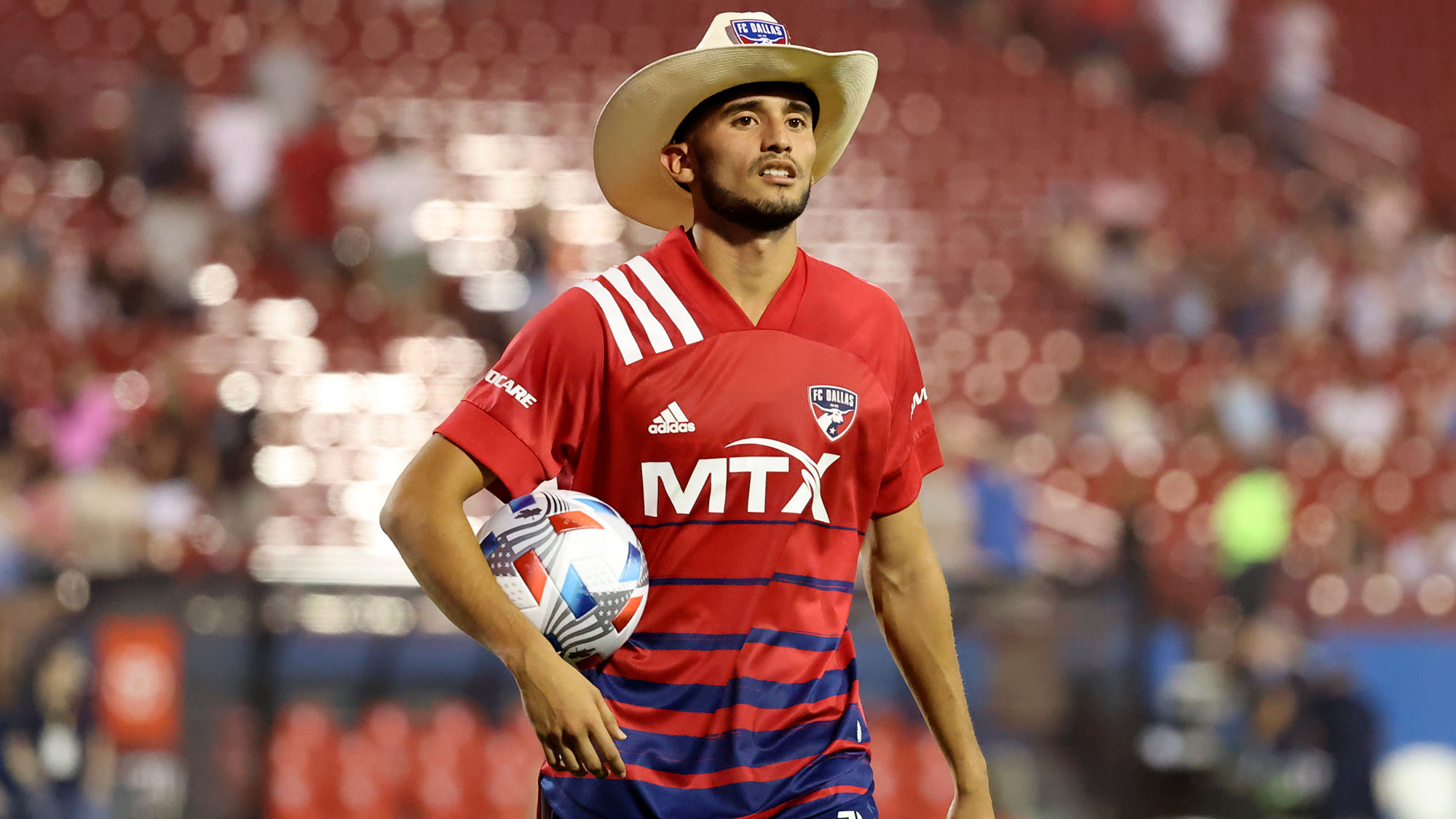The U.S.-Mexico Stakes Are Different for Ricardo Pepi

If the U.S.-Mexico men’s soccer rivalry has ever had a face, it was almost certainly furious, anguished, sneering or smug. It probably was one of antagonism. For all the blending and bonds that exist between the two countries, those ties rarely were evident on the field.
On the lists of all-time goals and appearances for the U.S., for example, there’s only one player of Mexican descent in the top 20: Carlos Bocanegra. And the former captain wasn’t someone whose life story or career embodied all those complex cross-border connections, at least publicly. Playing for Mexico wasn’t really an option. Bocanegra didn’t master Spanish until adulthood.
The U.S. certainly has featured multiple men with Mexican roots. It was Michael Orozco who scored the only goal in that friendly win at the Estadio Azteca back in 2012. Herculez Gomez, José Torres, Jonathan Bornstein and Omar Gonzalez are among those who played in recent World Cups. But there arguably hasn’t been an iconic Mexican-American U.S. national team player—one who anchored the side, stood the test of time, so clearly embodied both cultures and made a lasting impact on the rivalry.
That has a chance to change starting Friday night in Cincinnati, where the U.S. and El Tri will renew their unique feud in a World Cup qualifier at TQL Stadium. When the Americans (3-1-2) and Mexicans (4-0-2)—the top two teams in Concacaf’s Octagonal qualifying competition—take the field for the national anthems, U.S. striker Ricardo Pepi will be as familiar with one as he is with the other.

The 18-year-old FC Dallas product is deeply steeped in both American and Mexican heritage thanks to a life on the figurative and literal border. He was born and grew up in El Paso County, Texas, the son of Mexican parents who raised him to root for El Tri. Pepi trained with junior teams from both countries. But he slowly gravitated toward the U.S., appearing at the 2019 U-17 World Cup before finally committing his highly sought-after international future to the program this summer. Pepi’s impact has been swift and significant. He tallied three goals in his first two games—qualifiers against Honduras and Jamaica—and now appears to have beaten out the likes of Josh Sargent, Jordan Pefok, Daryl Dike, the injured Gyasi Zardes and others in the race to be coach Gregg Berhalter’s number-one No. 9.
Pepi has just four senior caps. Yet he appears to be the go-to striker in camp. Berhalter said last week that Pepi is penciled in to play a “large portion” of the upcoming games against Mexico and at Jamaica (Nov. 16). So on Friday, he’ll have the chance to fulfill a fascinating sort of destiny, leading one of his countries against the other while taking an intriguing first step toward becoming a uniquely symbolic face of Concacaf’s fiercest rivalry.
“I remember when I was 10, 11 years old, I remember just watching Mexico vs. the U.S. every time they’d play. It was a special feeling,” Pepi said Tuesday. “Having my family beside me … it was just rooting for Mexico back then. And now I’m representing the U.S.
“I feel like I’m going to get some goosebumps for sure,” he continued. “It’s going to be that feeling where I’m going to be very motivated for the game and I’m going to be prepared for it.”
Across the field, Pepi will see another potential path—the side he could’ve chosen. Compatriots in similar positions did go that way. LA Galaxy defender Julian Araujo and midfielder Efraín Álvarez, along with Real Salt Lake goalkeeper David Ochoa, are all native Californians who recently chose to represent Mexico. But none of them will be in Cincinnati. When Pepi considered both teams, he would have seen a U.S. program that’s undergoing a generational change and which is one of the youngest in the world. This month’s roster averages under 24 years of age. While Mexico can deploy seasoned strikers like Wolverhampton Wanderers star Raúl Jiménez and Monterrey’s Rogelio Funes Mori—each 30—there was room on Berhalter’s team for someone to make an impression. Pepi seized his opportunity.

“He’s come in and made a real statement. He obviously wants to solidify his place in the team. He’s been giving his all for the team every time he’s come out on the pitch. It’s something we all admire,” U.S. defender Antonee Robinson said Monday. “If he keeps producing goals and good performances like he has been, that might translate to us looking at him as our top No. 9. We’ve got a lot of depth in our team so he’s still got a long way to go for that, but he’s been doing very well.”
A goal and/or a good performance against Mexico will represent a decent step down that road. Berhalter has coached against El Tri four times now and despite winning twice (in this summer’s Gold Cup and Nations League deciders), he’s yet to get a goal from his striker. In fact, no U.S. striker has found the net against Mexico since the last time the pair contested a qualifier north of the border. That was Bobby Wood in November 2016, or seven meetings ago. The Americans need more from that position, especially if set pieces are going to continue playing a role in deciding games between the two. Now they’re turning to a player with considerable potential, who may add a compelling competitive and cultural wrinkle to an old rivalry.
“What I see from Ricardo is a very typical No. 9 mold of deadly in the penalty box, good off the ball movement, good linkup play and he just doesn’t need a lot to score goals. That’s a real quality of a good No. 9,” Berhalter told U.S. Soccer last month. “His understanding of the game is very good. His [recognition of] moments when to drop down and connect play is excellent. So he has a lot of good attributes and for him to be 18 years old, man, is really impressive.”
He’s 18 and already made one massive life decision this summer. But the opportunity and pressure didn’t stop there. He finished the MLS campaign with 13 goals in 31 games (24 starts), which obviously is an excellent return for a teenager. But production leads to expectations. Pepi scored just once in his final nine games for FCD, and the stakes are getting only higher. The U.S. will be counting on him this month, and high-profile European clubs are circling. He’ll have to master both the moment and his emotions in order to deliver on his promise.
His U.S. teammates have faith.
“He’s taken his opportunities really well. He’s showcased well in MLS, then coming here to the national team, he’s been great—scoring a bunch of goals, being a force up front. And for him, it’s just keep going out and doing what he’s doing,” veteran midfielder Kellyn Acosta said Tuesday.
"He’s a guy that’s pretty level-headed despite everything going on around him,” Acosta continued. “He’s done a great job of being confident and quietly being a quiet assassin on the field. Credit to him. [Friday’s qualifier] is just one of those games where he knows what’s at stake, and I think he’s ready.”
Pepi does seem level-headed. He comes across as humble and unassuming—someone who’s not in love with the sound of his own voice and who’s not about drawing attention to himself or making waves. Yet it says something that U.S. Soccer presented Pepi to the media Tuesday. Interest in his story is high. He represents not only something that the national team has been seeking since Jozy Altidore’s heyday—a clinical and consistent striker—but a possible subplot that U.S.-Mexico has been missing: a bona fide Mexican-American star.
Pepi said he followed players with that potential growing up, and that he was fueled by the prospect of a game like Friday’s.
“That was always just a theme that I had to have in the back of my head,” he said. “I remember that there were some players that I used to just follow their path and be able to put myself in those shoes, because I knew one day I was going to make the same decisions. It was a very important thing to be able to look out for.
“[My family has] talked about how special it would be and how motivating that would be for me, just to be able to be called up to the national team, to be able to play in that game,” he added. “That made me work harder as a player.”
They’ll be in attendance in Cincinnati. Pepi said he’ll have a personal supporters section of “at least 10” on Friday. We’re now accustomed to seeing families and friends at U.S.-Mexico games arriving and sitting together but wearing opposing jerseys. This is a matchup of friction and opposition, but also of connection. That’s a part of this soccer story, and Pepi could embody that more than any predecessor. Want to add yet another spark to this rivalry? Imagine a player with that background, who El Tri eagerly recruited, putting them to the sword.
If it happens Friday, his family will be thrilled. They may have helped raise him as a Mexico fan in Texas, but they’re now aboard the “Pepi train” like everybody else.
“They’re going to be supporting me and supporting the U.S.,” Pepi said.
More Soccer Coverage From Brian Straus:
